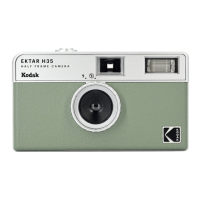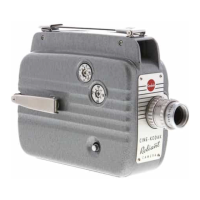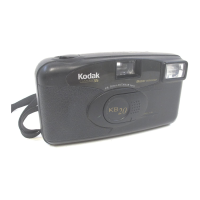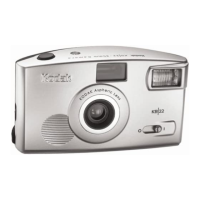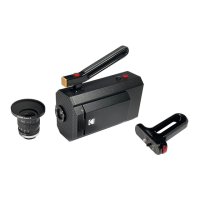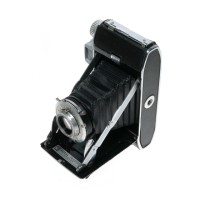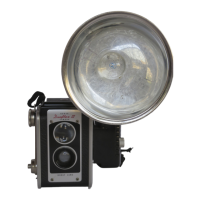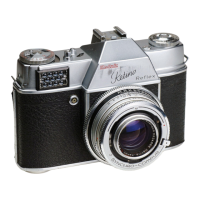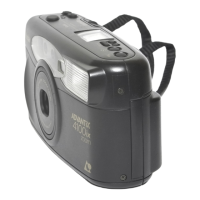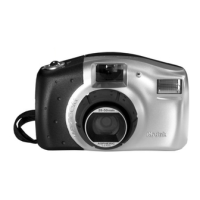14
PRINT
CONTROL
Under
most conditions, you will be
taking
pictures
with the print
(Lighten
/ Darken)
control
in the
center
position
.
However
, the
lightness
or
darkness
of
your
prints can be
affected by such factors as temperature, and
type and brightness
of
subject. The
print
control
helps you to
compensate
for
these
effects,
especially
in daylight
picture-taking
.
After
taking
a
picture
, if you
want
a
lighter
or
darker
picture
of
the same
subject
in the
same
location
without
changing
the
light
ing
or
your position, adjust the
print
control
before you take
another
picture
. To take a
lighter
picture
, move the
control
toward
Lighten; for a
darker
picture
, move the
con-
trol
toward
Darken.
The
print
control
does
not
automatically
return
to
the
center
posi
-
tion
after you
take
a
picture.
NOTE:
Setting
the
print
control
toward
Lighten
will not help you to get a
lighter
picture
if the red
low-light
signal appears in
the
viewfinder
.
If you use the print
control
to adjust
lightness
or
darkness
for
flash pictures
of
subjects
from 4 to 10 feet from the
camera
,
move the
control
al/ the way
(two
marks)
toward
Lighten
or
Darken. Remember, if you
take flash
pictures
of
subjects
outside the
correct
flash distance range (4 to 10 feet),
subjects
closer
than 4 feet will be too light,
and subjects farther than 10 feet will be
too
dark
regardless
of
the
print-control
setting.
Temperature
Effects
on
Prints
Best
picture
results will be
obtained
when
the
temperature
during
print
development
is
between 60 and 95 ° F (16 and 35 °C). At
temperatures
below
60°F (16°C),
place
prints in a warm
place-an
inside
pocket
,
for
example-as
soo
n as they are
ejected
from
the
camera
, and leave them there
during
development.
Otherwise
, prints may
appear
too
light. Be sure
not
to bend, flex,
or
fold
the
prints
.
When the
temperature
is above 95 °F
(35°C), set the
print
control
toward
Lighten
to prevent prints from
becoming
too
dark
.
Don't leave prints in direct
sunlight
or
on
a hot
surface
during
development
. Prints will
probably
be
too
dark
when
developed
at
temperatures
above 100°F (38°C).
See
your
film
instruction
sheet
for
com-
plete
information.
Subjects
and
Lighting
Conditions
In
certain
types
of
situations, you may
judge
your
subjects
to be too
light
or
too
dark
. For
example
, if you are
photographing
a very
light
subject
in very
dark
surroundings,
your
main
subject
may be too light in
your
print.
A
dark
subject
in
light
surroundings
may
appear
too
dark
. A
subject
in open shade
(shaded from the sun but lighted by a large
area
of
the sky) may appear too
dark
.
When you
recognize
these types
of
situa-
tions
, before taking the
picture
you can
sometimes adjust the
print
control
to achieve
more
accurate
exposure
of
the subject. For
a very
light
subject
in dark
surroundings
,
move the
print
control
toward Darken;
for
a
dark
subject
in
light
surroundings
, move
it
toward
Lighten. If you are
photographing
a
subject
on an overcast day
or
in open
shade
and
the red
low
-
light
signal appears
in the viewfinder
as you partially depress the
shutter
release,
your
pictures
will be
too
dark
unless you use flash. Moving the
print
con-
trol
toward
Lighten
will not help
to
produce
a
lighter
picture
.
14
PRINT
CONTROL
Under
most conditions, you will be
taking
pictures
with the print
(Lighten
/ Darken)
control
in the
center
position
.
However
, the
lightness
or
darkness
of
your
prints can be
affected by such factors as temperature, and
type and brightness
of
subject. The
print
control
helps you to
compensate
for
these
effects,
especially
in daylight
picture-taking
.
After
taking
a
picture
, if you
want
a
lighter
or
darker
picture
of
the same
subject
in the
same
location
without
changing
the
light
ing
or
your position, adjust the
print
control
before you take
another
picture
. To take a
lighter
picture
, move the
control
toward
Lighten; for a
darker
picture
, move the
con-
trol
toward
Darken.
The
print
control
does
not
automatically
return
to
the
center
posi
-
tion
after you
take
a
picture.
NOTE:
Setting
the
print
control
toward
Lighten
will not help you to get a
lighter
picture
if the red
low-light
signal appears in
the
viewfinder
.
If you use the print
control
to adjust
lightness
or
darkness
for
flash pictures
of
subjects
from 4 to 10 feet from the
camera
,
move the
control
al/ the way
(two
marks)
toward
Lighten
or
Darken. Remember, if you
take flash
pictures
of
subjects
outside the
correct
flash distance range (4 to 10 feet),
subjects
closer
than 4 feet will be too light,
and subjects farther than 10 feet will be
too
dark
regardless
of
the
print-control
setting.
Temperature
Effects
on
Prints
Best
picture
results will be
obtained
when
the
temperature
during
print
development
is
between 60 and 95 ° F (16 and 35 °C). At
temperatures
below
60°F (16°C),
place
prints in a warm
place-an
inside
pocket
,
for
example-as
soo
n as they are
ejected
from
the
camera
, and leave them there
during
development.
Otherwise
, prints may
appear
too
light. Be sure
not
to bend, flex,
or
fold
the
prints
.
When the
temperature
is above 95 °F
(35°C), set the
print
control
toward
Lighten
to prevent prints from
becoming
too
dark
.
Don't leave prints in direct
sunlight
or
on
a hot
surface
during
development
. Prints will
probably
be
too
dark
when
developed
at
temperatures
above 100°F (38°C).
See
your
film
instruction
sheet
for
com-
plete
information.
Subjects
and
Lighting
Conditions
In
certain
types
of
situations, you may
judge
your
subjects
to be too
light
or
too
dark
. For
example
, if you are
photographing
a very
light
subject
in very
dark
surroundings,
your
main
subject
may be too light in
your
print.
A
dark
subject
in
light
surroundings
may
appear
too
dark
. A
subject
in open shade
(shaded from the sun but lighted by a large
area
of
the sky) may appear too
dark
.
When you
recognize
these types
of
situa-
tions
, before taking the
picture
you can
sometimes adjust the
print
control
to achieve
more
accurate
exposure
of
the subject. For
a very
light
subject
in dark
surroundings
,
move the
print
control
toward Darken;
for
a
dark
subject
in
light
surroundings
, move
it
toward
Lighten. If you are
photographing
a
subject
on an overcast day
or
in open
shade
and
the red
low
-
light
signal appears
in the viewfinder
as you partially depress the
shutter
release,
your
pictures
will be
too
dark
unless you use flash. Moving the
print
con-
trol
toward
Lighten
will not help
to
produce
a
lighter
picture
.
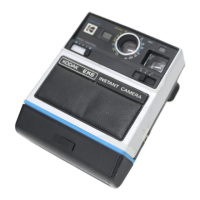
